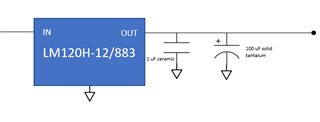I am working on refreshing a design that utilizes an LM120H-12/883 (the military grade LM320). The existing design utilized an old leaded (non-SMT) 1uF ceramic capacitor as well as a solid tantalum 100uF capacitor as the output filtering (and compensation). I note from the data sheet for the LM120QML that is linked from the LM120H-12/883 product page that a 1uF tantalum or a 25uF aluminum electrolytic is recommended for the output capacitor, and the specific absence of ceramic capacitors recommended for this purpose. I am aware that other linear regulators of this type that take their output from the collector of a bipolar transistor can exhibit stability issues with ceramic output capacitors due to those capacitors' low ESR. As part of the design refresh, the output capacitors will be migrated to SMT devices, including the 1uF ceramic, which may likely result in a lower value ESR for that capacitor than the existing design. Also, due to changes in other parts of the circuit, the output current drawn from this regulator is likely to decrease significantly, likely shifting the load pole of the regulator. Is there a risk that the revised regulator circuit will have stability issues due to the low ESR of an SMT ceramic output capacitor and the decrease in the output current drawn?
-
Ask a related question
What is a related question?A related question is a question created from another question. When the related question is created, it will be automatically linked to the original question.


